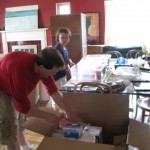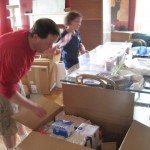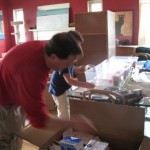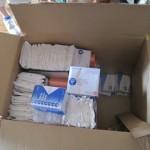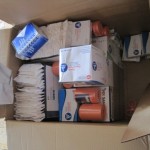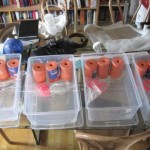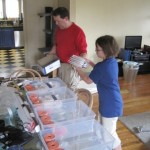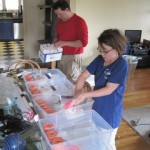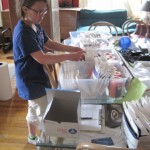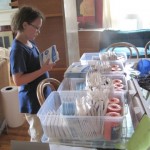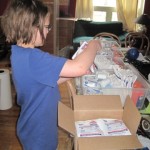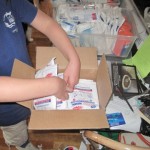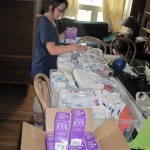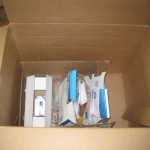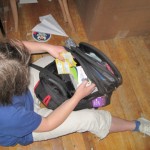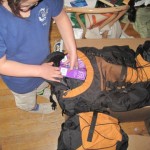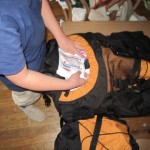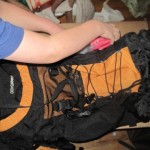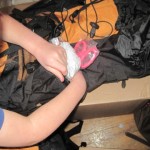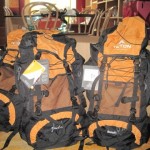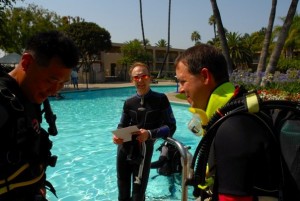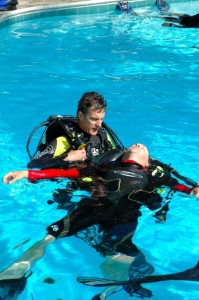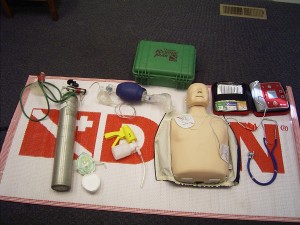This week included the second annual Great Utah ShakeOut. An earthquake drill involving government, schools, individuals and businesses. Chances are, many if not most buildings would be survivable, but there is a significant chance for injuries. The solution–be prepared–with training and supplies. For the Salt Lake Arts Academy, we’ve started putting together several trauma kits/disaster medical supplies.
Category Archives: Emergency Care
Aquarium Injuries
Aquarium injuries? Why is this on a scuba website?
DAN (Divers Alert Network) Hazardous Marine Life Injuries was originally created for scuba divers due to the potential for injury whilst diving. Aquarium workers and aquarium owners, though, can also benefit from this information. In addition to CPR and First Aid training, you’ll be well prepared for potential problems.
What you should know:
- First, make sure the scene is safe. If you’re providing care to someone that is injured, make sure you don’t become a victim. Alert EMS if needed.
- For jellyfish, the current guidelines are to use vinegar to neutralize the sting. Use tweezers to remove tentacles. Don’t touch them with your bare hands!
- For punctures from various spines, remove visible pieces with tweezers. Immerse in hot water for 30-90 minutes (113F/45C max).
- For bites, control bleeding with direct pressure. Once bleeding stops, bandage the wound. Monitor for shock and/or infection.
- For any severe reaction or signs/symptoms of shock, alert EMS.
For anyone working with aquatic life, I highly suggest you complete a CPR/First Aid class, the DAN Hazardous Marine Life Injuries class and the DAN Emergency Oxygen course. Combining the three, you’ll learn:
- Scene assessment, barrier use, primary assessment of an injured person
- CPR and Choking Management
- Shock, Spinal Injury and Serious Bleeding Management
- Bandaging and splinting
- Illness and Injury management
- How to set up and deliver emergency oxygen to an injured person using a non-rebreather mask, a demand valve, a manually-triggered ventilator and a bag-valve mask.
- Be able to identify four types of hazardous marine life injuries, name five venomous fish and list five common signs of envenomation.
- Be able to name at least three aquatic animals that might bite someone and list two common warning signs of a marine animal bite.
- and much more, but the most important thing is:
- You’ll practice how to take care of these problems
Not sure if there are many aquarium injuries? Check out this recent article in the Journal of EMS (JEMS) about a toddler bitten by a pet piranha.
This applies to not just home aquariums with exotic fish, but can also apply to commercial aquariums. I’ve often been told by aquarists I know that their hands are inflamed and feel odd after handling jelly fish. Luckily, none of them have had allergic reactions to the jellyfish.
Contact me now to talk about how you can be better prepared for aquarium injuries. If you are a diver working at an aquarium, I also teach the DAN Diving First Aid for Professional Divers course that also covers some skills at the healthcare-provider level.
[Also, don’t be worried about shark bites. They’re quite rare. Sharks have much more to fear from us than we do from them.]
Scuba Diving Emergency Management
Scuba Diving Emergency Management
All of the tenets of Emergency Management apply to scuba diving:
- Prevention/preparation
- Mitigation
- Response
- Recovery
Recreational scuba diving has a good track record of safety. That said, there are still a number of scuba diving emergencies that occur each year, many of which can be prevented. As with any activity, being prepared is key. How do we prepare to handle scuba diving emergencies?
- In the Open Water Diver Course, entry level divers are taught how to assemble their equipment, do a pre-dive check with a buddy and to dive with a buddy. The pre-dive check, checking BCD, Weights, Releases, Air and a final check of everything else, can catch a lot of problems. Too much weight, not enough air, etc.
- Also, in Open Water, entry level divers are taught how to adjust their gear underwater or deal with certain equipment issues underwater. By learning what to do, a bit of extra water in your mask doesn’t become a source of panic.
- Advancing on in education, through the Adventures in Diving/Advanced Open Water course, divers dive in different environments and practice new skills.
- In the PADI Rescue Diver Course, divers extend their skills to handle scuba diving emergencies, starting with a review of what they’ve already learned in Open Water and Advanced.
- The next step is to start paying attention to other divers behavior. Do they appear nervous (talking too much or not at all), unsure of what they’re doing (fumbling with gear), not ready for the dive (inappropriate scuba equipment), etc?
So far, that covers prevention and mitigation. How do we respond to problems?
- Like other emergency care, start with a scene assessment. Are there hazards? Is the diver missing and we need to search, or was the diver found unresponsive?
- A Rescue Diver builds a tool kit of skills in the PADI Rescue Diver course: assisting from shore or a boat, surfacing an unresponsive diver, attending to an unresponsive, non-breathing diver at the surface, egress.
- Rescue Divers also learn the basics of emergency management for a scuba diving emergency. This can be managing the scene, working with other responders, organizing logistics for a search & rescue, etc.
Since scuba diving is often done in remote locations, EMS isn’t readily available. Additional training on how to handle scuba diving emergencies can make a big difference in outcome. I highly recommend the DAN Training programs, including:
- DAN Oxygen Provider/Oxygen First Aid for Scuba Diving Injuries
- DAN Hazardous Marine Life Injuries
- DAN On-Site Neurological Assessment for Divers (Neuro)
- DAN Dive Medicine for Divers I: more about diving accidents and conducting physical exams, including respiratory
- DAN Dive Medicine for Divers II: barotraumas, decompression illness, practicing how to use an EpiPen and taking blood pressure.
- DAN Dive Medicine for Divers III: Gas toxicities, drowning, ear barotrauma and using an otoscope.
Beyond the response to a scuba diving emergency, Rescue Divers also learn how to help the diver and themselves recover from an incident. This starts in the response phase: if the injured diver can help with their own care, that gives them a sense of control which will help their recovery. For the Rescue Diver, learning about how to handle their own stress after an incident can help them personally recover.
All of these skills are reviewed and practiced at higher levels in diver education. Divemasters and Scuba Instructors need to be able to respond to scuba diving emergencies and manage them.
CPR guideline changes
In October 2010, guidelines for CPR were changed. It’s now C-A-B, circulation, airway, breathing.
This does not mean your prior training is out of date, it just means that the latest research shows the new guidelines may be more effective in helping patients.
Contact me to sign up for a refresher today. If it’s been more than 2 years since your last CPR course, you’re overdue!
Emergency First Response (CPR/First Aid)
Emergency First Response (EFR) consists of Primary Care(CPR) and Secondary Care(First Aid). CPR(cardiopulmonary resuscitation) covers life-threatening situations starting with the C-A-B’s, circulation, airway and breathing [2010 Guidelines] including defibrillation, shock management, spinal injury management and serious bleeding management. First Aid is used for non-life threatening injuries when EMS is delayed or unavailable.
The Emergency First Response course is open to anyone of any age with an interest in helping others.
Primary Care(CPR) training includes:
- Scene Assessment
- Barrier Use(pocket mask & gloves)
- Primary Assessment
- Cardiopulmonary Resuscitation (CPR)
- Serious bleeding management
- Shock management
- Spinal injury management
- Automated External Defibrillator (AED) training
- Assisting a conscious choking adult
- Emergency Oxygen
Secondary Care (first aid) training includes:
- Injury Assessment
- Illness Assessment
- Bandaging
- Splinting for dislocations and fractures
With the self-study materials, we can spend most of the class time actually doing the skills, which is the best way to learn CPR and First Aid. In many cases, with self-study, the course can be done in about 4-5 hours. Emergency First Response courses can be customized if you need a certain number of contact hours.
Course materials (manual, DVD, pocket mask and gloves) are included.
